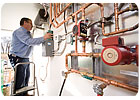Keeping 36 Feet Warm

When the Discovery Channel focuses the attention of an entire camera crew on something or someone, and dedicates hours of TV time to a six-part news series, you know there’s a story to be told. And, not to be outdone, the Learning Channel aired a show about the family's home construction project, competed last spring.
That’s the case with the Duggar family of Tontitown, Ark. The story? Basically, a young couple with 16 natural children and going for more.
For the past three-and-a-half years, former Arkansas state Representative Jim Bob Duggar, 40, and his wife, Michelle, 39, have been working on a 7,000 square foot home that now includes a fully outfitted commercial kitchen, four washers, four driers, nine bathrooms, and two ganged, dormitory-style bedrooms for the kids and a large music room. Just inside the front door, a large open space serves as a multipurpose living room and kitchen. At a total of 2,000 square feet in area, “it's about the same size as the entire house we lived in prior to this one,” Jim Bob says.
Each member of the family participated in the home’s construction. “Our whole goal in building this house was to be a learning project, a family project, together,” Michelle says. The Duggar’s built the all-steel house from a kit, and what began as a family project came to include the assistance of extended “family” from the church and other friends.
What you may not have seen on TV was the home’s radiant heating system. While the family did do a lot of work themselves, they did contact professional tradesmen as each next step in the construction process was reached. The Duggars either looked for a professional to teach them the necessary skills to complete the job or, in the case the radiant system, to “hire” the family as a labor force.
On the day that Tom Atchley, one of the owners of Fort Smith, Ark.-based Oren Atchley Co., first visited the jobsite to bid on completing the heating and air conditioning system, the Duggar’s oldest son, Josh, was capably digging gas, water and sewer line trenches with a backhoe.

Toasty Toes
Jim Bob knew he needed the best way to provide heating hot water. Their last home was drafty and hard to heat, and its 40-gallon water heater was no match for the growing family.Atchley won the job for his firm to assemble and fine-tune all of the essential mechanical system components, including four zones of radiant heat and a sturdy, wood-fired boiler, chosen because they have plenty of fuel growing on the property. And – with several growing boys to cut and chop the wood – there was a ready resource for that, too.
The boiler’s heat exchanger produces most of the family’s domestic water needs through a built-in, plate-to-plate heat exchanger. A 75-gallon, LP gas Bradford White water heater serves as the back up for six months of the year, and as the primary source in the boiler’s off-season.
Atchley technicians fabricated the hydronic module at their shop. It has a primary/secondary design with outdoor reset control. Vanguard provided all of the components for the expansive first floor’s radiant heat system. And, since most of the insulated, on-grade, in-slab tubing is topped-off with tile flooring above, they’re enjoying radiant heat at its best.
The radiant load on the first floor is 78,355 Btus. This is broken up into four zones:
- Zone 1 includes 1,440 lineal feet of tubing and the load is 21,159 Btu.
- Zone 2 is 1,440 feet and its load is 30,065 Btu (higher because it’s open to the second floor, with a 23-foot ceiling and lots of glass).
- Zone 3 is 1,440 feet, with a 12,286 Btu load.
- Zone 4 is 744 feet with a load of 14,745 Btu.
The hydronic control panel constructed by Atchley is the heart of the system. It’s powered by five Grundfos, three-speed SuperBrute circulators. “We were among the early adopters with multispeed circs,” Atchley says.
One of the most important facets to optimal circulation for hydronic systems is for contractors to match a pump’s performance, or flow characteristics, to the specific job that it needs to perform within the system. A single-speed pump has one performance curve - a measurement of head and flow - and operates at that level only, with great predictability. But these new circulators, Atchley adds, offer a much broader range of performance. With the flick of a switch, various speeds can be chosen, easily changing head and flow to meet the specific needs of the system.
“We use the manufacturer’s pump curve to select the proper pump for each zone,” says David Kuykendall, Atchley Co.’s head technician and lead, in-house trainer. “In the past, we might have three or four different pump models on one job, all selected to match the exact needs that we’ve determined. With multispeed pumps, we can use one pump and select the speed to match the flow and head that we want.”
Other Atchley technicians on the job included Matt Holsted, installation foreman, and journeymen Fred Henson and Jim Roberson.
“The Duggar’s hydronic system has versatility built in,” Atchley adds. “We made it as capable and as flexible as possible. After all, it’s a growing household with a whole lotta’ bare feet on those tile floors.”
Links
Looking for a reprint of this article?
From high-res PDFs to custom plaques, order your copy today!



